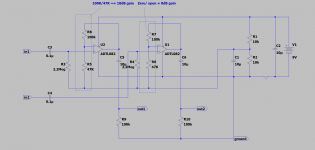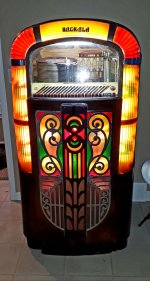https://www.turntableneedles.com/As...e-Ceramic-Record-Player-Cartridge_p_2274.htmlHello,
BUT, which ceramic cartridge ???
Brand, model, ref ???
Voltage output : 0.7V
Freq Range : 30-15K
1. If you want any bass from a ceramic cartridge (or any piezo transducer), a 1meg ohm input impedance is minimal. 2.2 meg Ohms or higher is recommended. They do not require RIAA eq when used with a hi-impedance input such as was typical of very simple vacuum tube record players.
2. Instrument amplifiers like ina217 are too slow for audio and the DC precision is useless.
3. For this purpose, a FET input op-amp is the best choice, with gain minimal or none. Years ago, I had a Phillips cassette recorder where the line inputs were a 2.2Meg resistor to the (unbalanced) microphone input, and that worked well with ceramic cartridges.
2. Instrument amplifiers like ina217 are too slow for audio and the DC precision is useless.
3. For this purpose, a FET input op-amp is the best choice, with gain minimal or none. Years ago, I had a Phillips cassette recorder where the line inputs were a 2.2Meg resistor to the (unbalanced) microphone input, and that worked well with ceramic cartridges.
Last edited:
That is excellent information. All I need is a circuit diagram. Is it possible that you can provide this for me? Thanks1. If you want any bass from a ceramic cartridge, a 1meg ohm input impedance is minimal. 2.2 meg Ohms or higher is recommended. They do not require RIAA eq when used with a hi-impedance input such as was typical of very simple vacuum tube record players.
2. Instrument amplifiers like ina217 are too slow for audio and the DC precision is useless.
3. For this purpose, a FET input op-amp is the best choice, with gain minimal or none. Years ago, I had a Phillips cassette recorder where the line inputs were a 2.2Meg resistor to the (unbalanced) microphone input, and that worked well with ceramic cartridges.
Ok, so this is a high impedance buffer for two channels. I used TL082 because it's in the LTC library but TL072 is probably better choice. Note that this shows two single op-amps, but TL072/82 are a dual where both share the supply pins. I show feedback for 10dB gain but you may want to adjust that for whatever gain works with your system. Gain = 20log((R8+R5)/R5) and 20log((R7+R6)/R6). A 9V battery is probably enough but you may want two, ie 18V.
I agree with Icsaszar about wearing out your vinyl with a ceramic cartridge.
I agree with Icsaszar about wearing out your vinyl with a ceramic cartridge.
Attachments
Last edited:
https://www.keith-snook.info/wirele...ss-World-1971/Ceramic Pickup Equalisation.pdfI do remember many years ago a dedicated preamp appearing in Wireless World and it was designed to get the very best possible performance from ceramics and was reputed (using some of the best cartridges) to rival some top moving magnet cartridges and preamps. Everything hinged on getting the loading correct, very high impedance but I recall there was more to it than just that.
This the cartridge that is used on my 1946 Rock-ola jukebox. It plays 78 RPM shellac records and tracks at 8 grams.I would reverse the question: do you insist on this cartridge? It will sooner or later ruin your LPs. You could buy a modern MM (moving magnet) cartridge for $55. Unless it is the 78rpm version, but there are alternatives for it, too.
Attachments
Steveu,Ok, so this is a high impedance buffer for two channels. I used TL082 because it's in the LTC library but TL072 is probably better choice. Note that this shows two single op-amps, but TL072/82 are a dual where both share the supply pins. I show feedback for 10dB gain but you may want to adjust that for whatever gain works with your system. Gain = 20log((R8+R5)/R5) and 20log((R7+R6)/R6). A 9V battery is probably enough but you may want two, ie 18V.
I agree with Icsaszar about wearing out your vinyl with a ceramic cartridge.
Excellent! I really appreciate your efforts on this. Would you be willing to share the LTspice asc file?
This ceramic cartridge will be used on 78 rpm shellac records not vinyl. Shellac is much harder than vinyl.
Thanks again
Scott
Last edited:
I see. My family had a Garrard record changer when I was young. It had a ceramic cartridge with sapphire stylus. There were two styli on the cantilever, and it could be turned over to play 78s.This the cartridge that is used on my 1946 Rock-ola jukebox. It plays 78 RPM shellac records and tracks at 8 grams.
I was keen on experimenting, and I read somewhere the following trick: load the cartridge with 1k resistor. That converted the piezo crystal to a current output device (the current on the resistor was roughly proportional to groove velocity), so it could be directly connected to a phono input having RIAA equalization. It worked well, as far as I remember.
I posted this a day or so ago. Read the entire thread next time:And we still don't know WHAT amplifier is to be used, or a schematic at least of its input circuitry.
What's the secret about it?
Nothing special about the amp! Standard modern solid state amp/pre-amp with standard RCA unbalanced line level inputs (example: CD player)
Yes you are out … out of your mind. What is with you people. The problem was solved a day ago. Plus your a sexist idiotPossibly the OP is female, they like to be mysterious.
Let her break her / his / its head, I am out.
Nothing special about the amp. Standard modern solid state amp/pre-amp with standard RCA unbalanced line level inputs (example: CD player)
I'm sorry that I was not more clear. I want to have a circuit that would allow me to connect a ceramic cartridge to "any" line level input device. Examples would be an audio amplifier, video receiver, computer sound card, and Mini DSP.And we still don't know WHAT amplifier is to be used, or a schematic at least of its input circuitry.
What's the secret about it?
I'm sorry that I was not more clear. I want to have a circuit that would allow me to connect a ceramic cartridge to "any" line level input device. Examples would be an audio amplifier, video receiver, computer sound card, and Mini DSP.Possibly the OP is female, they like to be mysterious.
Let her break her / his / its head, I am out.
A generic no name amp?
Or a shop purchased item with a brand name and model number?
Do it yourself amp?
How much output?
Or a generic pre amp circuit? As an all in one level matching device?
Female or not, you are being mysterious and confused.
And ceramic cartridges went out of fashion long back.
Also, their output at times is enough for some amps. No need for a pre amp.
Or a shop purchased item with a brand name and model number?
Do it yourself amp?
How much output?
Or a generic pre amp circuit? As an all in one level matching device?
Female or not, you are being mysterious and confused.
And ceramic cartridges went out of fashion long back.
Also, their output at times is enough for some amps. No need for a pre amp.
Last edited:
- Status
- Not open for further replies.
- Home
- Source & Line
- Analogue Source
- Ceramic cartridge to line level input circuit

